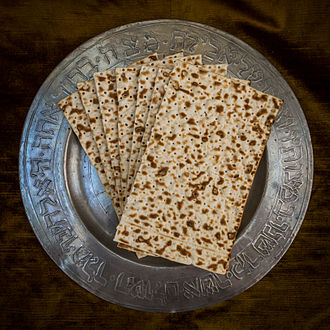Matzah
Matzah (also spelled Matzo, Matza, or Matzoh) is an unleavened bread that is a key element in the Jewish observance of Passover. This flatbread is made simply from flour and water, and it is baked until it is crisp. The significance of matzah lies in its connection to the Exodus from Egypt, when the Israelites left in such haste that they could not wait for their bread to rise. As a result, matzah is eaten during the eight-day festival of Passover to commemorate this event and to fulfill the commandment to eat unleavened bread.
History and Significance
The history of matzah is deeply intertwined with the Jewish people's history and their liberation from slavery in ancient Egypt. According to the Torah, the Israelites had to leave Egypt so quickly that there was no time for their dough to rise. In memory of this, eating matzah during Passover serves as a reminder of the haste with which their ancestors left Egypt and the freedom they achieved.
Preparation and Types
Matzah is traditionally made from wheat, although it can also be made from other grains such as barley, spelt, rye, or oats, in accordance with Jewish dietary laws (Kashrut). The process of making matzah is carefully controlled to prevent fermentation, and the dough must be baked within 18 minutes after the flour is mixed with water, the time believed to be the threshold before natural leavening begins.
There are several types of matzah available:
- Shmurah Matzah: This is a special type of matzah where the wheat used is guarded from moisture from the time of harvest to ensure it does not ferment.
- Egg Matzah: Made with fruit juice or eggs in addition to water, this type is softer and has a different flavor but is not used to fulfill the commandment during the Passover Seder.
- Whole Wheat Matzah: Made from whole wheat flour, offering a healthier alternative.
- Gluten-Free Matzah: For those who cannot consume gluten, there are options made from gluten-free grains.
Cultural and Religious Practices
During Passover, it is a religious obligation for practicing Jews to eat matzah on the first night of the festival during the Seder, a ritual meal that includes reading the Haggadah, drinking four cups of wine, and eating symbolic foods. Matzah is also eaten throughout the eight days of Passover in place of leavened bread.
Matzah has also found its way into various Jewish dishes, such as Matzah Ball Soup and Matzah Brei, where it is used as a primary ingredient.
In Modern Times
Today, matzah is produced on a large scale by automated factories, although handmade varieties are still highly valued for religious purposes. The production and sale of matzah represent a significant aspect of Jewish cultural and religious life, especially during the Passover season.
Transform your life with W8MD's budget GLP-1 injections from $125.
W8MD offers a medical weight loss program to lose weight in Philadelphia. Our physician-supervised medical weight loss provides:
- Most insurances accepted or discounted self-pay rates. We will obtain insurance prior authorizations if needed.
- Generic GLP1 weight loss injections from $125 for the starting dose.
- Also offer prescription weight loss medications including Phentermine, Qsymia, Diethylpropion, Contrave etc.
NYC weight loss doctor appointments
Start your NYC weight loss journey today at our NYC medical weight loss and Philadelphia medical weight loss clinics.
- Call 718-946-5500 to lose weight in NYC or for medical weight loss in Philadelphia 215-676-2334.
- Tags:NYC medical weight loss, Philadelphia lose weight Zepbound NYC, Budget GLP1 weight loss injections, Wegovy Philadelphia, Wegovy NYC, Philadelphia medical weight loss, Brookly weight loss and Wegovy NYC
|
WikiMD's Wellness Encyclopedia |
| Let Food Be Thy Medicine Medicine Thy Food - Hippocrates |
Medical Disclaimer: WikiMD is not a substitute for professional medical advice. The information on WikiMD is provided as an information resource only, may be incorrect, outdated or misleading, and is not to be used or relied on for any diagnostic or treatment purposes. Please consult your health care provider before making any healthcare decisions or for guidance about a specific medical condition. WikiMD expressly disclaims responsibility, and shall have no liability, for any damages, loss, injury, or liability whatsoever suffered as a result of your reliance on the information contained in this site. By visiting this site you agree to the foregoing terms and conditions, which may from time to time be changed or supplemented by WikiMD. If you do not agree to the foregoing terms and conditions, you should not enter or use this site. See full disclaimer.
Credits:Most images are courtesy of Wikimedia commons, and templates, categories Wikipedia, licensed under CC BY SA or similar.
Translate this page: - East Asian
中文,
日本,
한국어,
South Asian
हिन्दी,
தமிழ்,
తెలుగు,
Urdu,
ಕನ್ನಡ,
Southeast Asian
Indonesian,
Vietnamese,
Thai,
မြန်မာဘာသာ,
বাংলা
European
español,
Deutsch,
français,
Greek,
português do Brasil,
polski,
română,
русский,
Nederlands,
norsk,
svenska,
suomi,
Italian
Middle Eastern & African
عربى,
Turkish,
Persian,
Hebrew,
Afrikaans,
isiZulu,
Kiswahili,
Other
Bulgarian,
Hungarian,
Czech,
Swedish,
മലയാളം,
मराठी,
ਪੰਜਾਬੀ,
ગુજરાતી,
Portuguese,
Ukrainian
Contributors: Prab R. Tumpati, MD
















